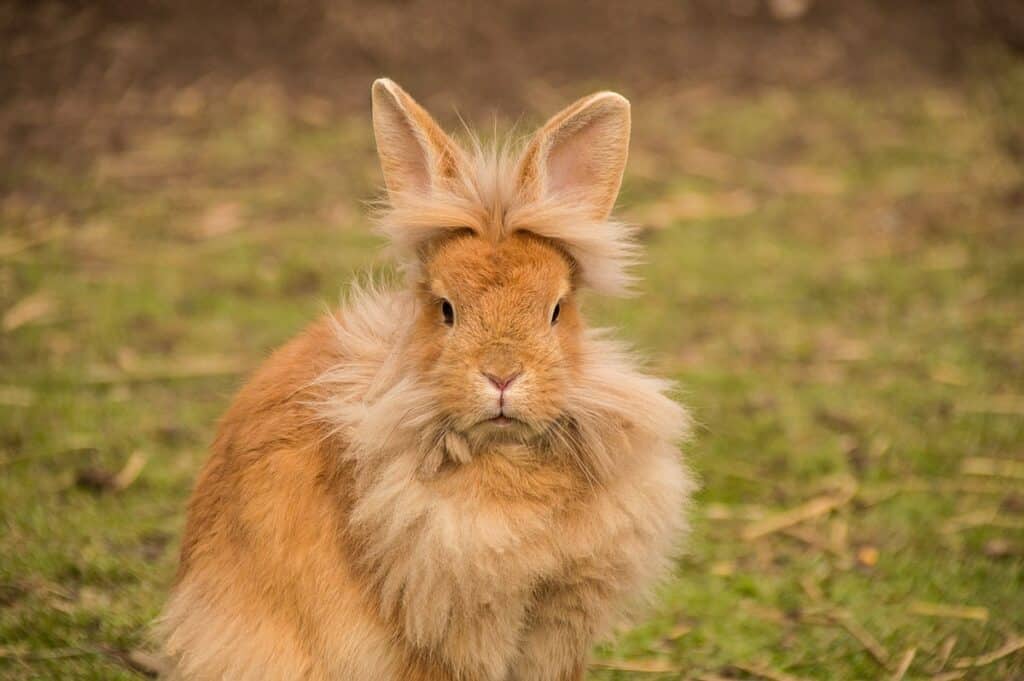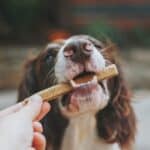Lion head rabbit: character, education, appearance

Do you know the lion head rabbit ? It is a dwarf rabbit and in fact its weight hardly exceeds 1.8 kg. Sensitive and affectionate, he needs a diet rich in fiber. Let’s see why.
The lion’s head rabbit has been known in Europe since the early Eighties , while in America, this breed is almost a novelty, as it was officially recognized by the American Rabbit Breeders Association (ARBA), only in 2014, as a fruit of a genetic mutation.
Lion’s head rabbit: typical appearance
Straight ears, alert eyes, long hair present in different colors. It is the lion’s head rabbit, a small pet that does not exceed 1.8 kg in weight.
Like all rabbits, this specimen too has a 190 ° view with a single blind spot at the nose.
Its name derives from the fact that its fur appears thicker around the neck and cheeks , almost forming a lion’s crest.
The classic specimen has a golden cream colored fur, but there are also white rabbits with blue eyes , chocolate , seal , and piebald blue point and tortoise .
Lion head rabbit: character
Sweet, sociable and outgoing , he becomes attached to his family after a few days. In fact, he must gradually get used to his presence. The first few days house him in the cage and talk to him but don’t take him.
The important thing is to leave him free to explore, trying to respect his times , and never force him into interactions, but rather reward him, every time he takes a step forward (even metaphorical). And never stop talking to him.
Being very docile, it is the ideal companion animal for a family with children . As long as they are not too small, as violent or abrupt gestures could compromise his health, given the fragile bones.
He loves being in a group, so it won’t be difficult for him to immediately recognize his master and treat others as his companions. The sympathy with other animals is less immediate. The lion’s head rabbit will calmly get used to both a dog and a cat.
But it is generally not recommended to leave them alone as both could hurt him by playing with them. The dog breed that best suits this animal is the Cavalier King .
Similar speech for other examples of lion’s head rabbit. Always get used to them a little at a time, before putting them together in the same cage and keep in mind that rabbits give birth a lot (3/4 specimens at a time) and generally already after 4/7 months of age .
Through teeth, legs and ears, the lion’s head rabbit is able to communicate his moods . When he grinds his teeth, for example, he may be sick or restless, while when he makes sounds with the help of his front teeth, he is basically purring.
If he snorts or blows he is nervous, while when he hits his hind legs on the ground he is worried or tense . Small taps of the muzzle on the hand are instead a sign of affection , and often accompanied by a lick.
Lion’s head rabbit: care
If well cared for, the lion’s head rabbit can live up to 10 years . Like all rabbits, it has very sensitive ears, which absolutely must not be pulled. Her teeth grow constantly, so it is important that her diet is varied and high in fiber to avoid malocclusion.
Fiber is also important in warding off gastrointestinal complaints, obesity and stones. A diet based on hay , grass , fresh vegetables and pellets is generally recommended . The foods that must absolutely be avoided, however, are carbohydrates, as they involve the birth of bacteria in the intestine.
Food must never be lacking, as lacking it could upset it. It is also important not to let him wander around the house unattended, and to periodically keep an eye on his teeth, his weak point, as they are likely foci of abscesses or infections.
It is also necessary to pay attention to the ears, eyes and hair, which must be combed once a week to avoid the formation of knots but also that your rabbit ingests it in excess. Once a day, however, during the moult.
Remember, however, at the same time, not to always leave him in the cage. The council is a social animal so it is good to spend as much time as possible with him outside the cage, as soon as you return home. Excessive time spent in captivity will turn him into a nervous, unhappy and obese dwarf rabbit .
The lion’s head rabbit can be housed both in the apartment and outside , as it is particularly robust; the ideal would be a house that allows him to live in complete safety both indoors and outdoors , so that he can enjoy the grass and the sun but sheltered from predators.
Diseases and health problems of the lion’s head rabbit
In any case, the cage should always be wide enough to allow your pet to be comfortable and move around. Never use softwood (such as pine and cedar) for bedding, as it can cause respiratory problems . A good trick could be to use a soft cloth.
Mange, which causes lesions to the skin around the eyes, ears, and nails, is a condition that also affects rabbits . But it can be easily cured with an acaricide. Be careful because if neglected, it can lead to death.
Treat your rabbit with a pesticide also to avoid flea attacks . Particularly dangerous as it can cause Myxomatosis and Viral Hemorrhagic Disease. The first is incurable but is avoided with vaccinations; the second is almost asymptomatic but also fatal.
Make sure its back is always clean as feces may attract flies that like to lay eggs in its fur. Symptoms that your pet is in a state of discomfort are dental crowding, shiny eyes, bumps on the skin and diarrhea .
Finally, always check that the lion’s head rabbit has eaten, as if it is fasted for 24 hours , its intestines become blocked causing a slow and dangerous decline.
Lion head rabbit price
The cost of a lion’s head rabbit is not particularly high , but it is important to keep in mind, before buying one, what the ancillary costs could be. In addition to the cage, the material for the bed and the food, the expense for his physical well-being must be evaluated, for example for toilet and veterinary care.
More than in shops, we recommend getting a lion’s head rabbit from rabbit shelters or breeders . Often, in fact, the specimens present in the shops have undergone a long and exhausting transport, which can expose them to the risk of stress and disease.
How much does a lion head rabbit grow?
The lionhead rabbit can weigh two kilos . It has quite large ears (more than 7 cm long). Its body has a rounded shape and the legs are quite strong, not as thin as those of other rabbits. Their eyes can be of various colors, such as red, brown or blue.
How to care for a Lion Head rabbit?
As with other pets, knowing how to care for a lionhead rabbit implies always complying with important aspects so that it has a healthy life.
- Due to the density of their hair, they must be brushed frequently to avoid hair knots , especially in the mane. In addition, this way you can prevent the rabbit from swallowing its hair and forming balls in its stomach.
- Being long-haired, the lionhead rabbit is especially susceptible to high temperatures. To avoid heat stroke, it should be kept in ventilated, cool or shaded places.
- Feed him malt paste a couple of times a week. Lionhead rabbits ingest a lot of their fur , which can be harmful to their stomachs. Your rabbit probably doesn’t like malt, so we recommend putting it on his paws. In this way, when you go to clean it, you will have no other choice and you will also eat the malt.
- It is not necessary to know how to bathe a lion head rabbit because it is harmful to him.
- Exercise is essential in your day to day . Therefore, when choosing a cage for him, it is recommended that it be large enough so that he can move freely when he is not loose.
- At the same time, he will need to get out of the cage at certain times of the day to run and play. This will prevent you from reaching high levels of stress.
Origins of the Lionhead rabbit
The origins of the lionhead rabbit breed remain in doubt. The theory that has become official is the one that holds Belgium as the place where the Lionhead rabbit was created from the cross between the Swiss Fox and Belgian Dwarf breeds. Other ideas hold that the lionhead rabbit comes from dwarf individuals. However, and a bit in contradiction with the first of the theories exposed, it is known that it is England where the Lionhead rabbit, as it is known today, has been shaped.
Lionhead rabbit hatchlings
Most lionhead rabbits are mature enough to mate when they reach 4 to 4 1/2 months of age. The female will give birth to the young at 31 or 34 days, after mating. In general, this breed of rabbits usually have between 2 to 4 young, the average size of the litter being 4 bunnies.
When the young are born, they are hairless and cannot see, so they are completely dependent on their mother. Their hair begins to grow 5 or 6 days later and they open their eyes after 10 or 12 days.
Do you know if your rabbit is female or male?
To find out if your lionhead rabbit is male, you will have to wait until 8 weeks. In the first weeks of life, the genitalia of rabbits cannot yet be seen externally. Very close to the tail, just after the anus, you will find another circular hole. If we press a little very carefully, we will appreciate his penis in the form of a small cylinder. If you do not see yourself trained, after three or four months the testicles usually go down completely and you can know with more certainty that it is a male.
In females, also very close to the tail, just below the anus we can find a second hole with a much more oval shape than circular as in males.
What can a lion head rabbit eat?
As with all rabbit breeds, the lion’s head will need a diet based mainly on hay . We can also add protein-rich feed and some green leafy vegetables or fruits to their diet . Vegetables and fruits should not be overused, as they could cause health problems.
Can this breed of rabbits be trained?
Although it is not as easy as training a dog, lionhead rabbits are usually very sociable and intelligent. Therefore, it will only take time, patience and a good reward as a reward when the rabbit does what we want. With perseverance and patience we will get our rabbit to heed certain orders, come to us saying his name or even relieve himself in his corner.
How long does a lionhead rabbit live?
With proper care and feeding you will be able to enjoy the company of your little rabbit for approximately 10 years.
You should also take into account that you will have to assume certain costs for their regular care, among the expenses are:
- Acquisition of pens and hutches.
- Much hay.
- Feed.
- Visits to the vet.
- Nail trimming and tooth file (when necessary).
- Vaccines.
- Medicines and / or products to prevent any disease.
How to know if my rabbit is Lion’s Head?
Its body is compact and short. Perhaps you can confuse it with the Angora rabbit since they both have a lot of fur around their head. The Angora has very long hair all over its body, including the head and ears, whereas the Lion Head Rabbit has a large amount of hair only around its head.






